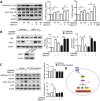GPR40 agonist ameliorates liver X receptor-induced lipid accumulation in liver by activating AMPK pathway
- PMID: 27121981
- PMCID: PMC4848522
- DOI: 10.1038/srep25237
GPR40 agonist ameliorates liver X receptor-induced lipid accumulation in liver by activating AMPK pathway
Abstract
Hepatic steatosis is strongly linked to insulin resistance and type 2 diabetes. GPR40 is a G protein-coupled receptor mediating free fatty acid-induced insulin secretion and thus plays a beneficial role in the improvement of diabetes. However, the impact of GPR40 agonist on hepatic steatosis still remains to be elucidated. In the present study, we found that activation of GPR40 by its agonist GW9508 attenuated Liver X receptor (LXR)-induced hepatic lipid accumulation. Activation of LXR in the livers of C57BL/6 mice fed a high-cholesterol diet and in HepG2 cells stimulated by chemical agonist caused increased expression of its target lipogenic genes and subsequent lipid accumulation. All these effects of LXR were dramatically downregulated after GW9508 supplementation. Moreover, GPR40 activation was accompanied by upregulation of AMPK pathway, whereas the inhibitive effect of GPR40 on the lipogenic gene expression was largely abrogated by AMPK knockdown. Taken together, our results demonstrated that GW9508 exerts a beneficial effect to ameliorate LXR-induced hepatic steatosis through regulation of AMPK signaling pathway.
Figures





Similar articles
-
Multiple mechanisms of GW-9508, a selective G protein-coupled receptor 40 agonist, in the regulation of glucose homeostasis and insulin sensitivity.Am J Physiol Endocrinol Metab. 2013 Mar 15;304(6):E668-76. doi: 10.1152/ajpendo.00419.2012. Epub 2013 Jan 22. Am J Physiol Endocrinol Metab. 2013. PMID: 23341496
-
The GPR40 novel agonist SZZ15-11 improves non-alcoholic fatty liver disease by activating the AMPK pathway and restores metabolic homeostasis in diet-induced obese mice.Diabetes Obes Metab. 2024 Jun;26(6):2257-2266. doi: 10.1111/dom.15539. Epub 2024 Mar 18. Diabetes Obes Metab. 2024. PMID: 38497233
-
Activation of free fatty acid receptor 1 improves hepatic steatosis through a p38-dependent pathway.J Mol Endocrinol. 2014 Oct;53(2):165-74. doi: 10.1530/JME-14-0003. Epub 2014 Jul 9. J Mol Endocrinol. 2014. PMID: 25008074
-
Barley sprout extracts reduce hepatic lipid accumulation in ethanol-fed mice by activating hepatic AMP-activated protein kinase.Food Res Int. 2017 Nov;101:209-217. doi: 10.1016/j.foodres.2017.08.068. Epub 2017 Sep 12. Food Res Int. 2017. PMID: 28941686
-
Vaccarin ameliorates insulin resistance and steatosis by activating the AMPK signaling pathway.Eur J Pharmacol. 2019 May 15;851:13-24. doi: 10.1016/j.ejphar.2019.02.029. Epub 2019 Feb 16. Eur J Pharmacol. 2019. PMID: 30779918
Cited by
-
GPR40 receptor activation promotes tight junction assembly in airway epithelial cells via AMPK-dependent mechanisms.Tissue Barriers. 2018;6(2):1-12. doi: 10.1080/21688370.2018.1480741. Epub 2018 Aug 29. Tissue Barriers. 2018. PMID: 29913106 Free PMC article.
-
Recent Developments in Drug Design of Oral Synthetic Free Fatty Acid Receptor 1 Agonists.Drug Des Devel Ther. 2024 Dec 11;18:5961-5983. doi: 10.2147/DDDT.S487469. eCollection 2024. Drug Des Devel Ther. 2024. PMID: 39679134 Free PMC article. Review.
-
GPR40 Agonism Modulates Inflammatory Reactions in Vascular Endothelial Cells.Diabetes Metab J. 2022 May;46(3):506-511. doi: 10.4093/dmj.2021.0092. Epub 2022 Jan 24. Diabetes Metab J. 2022. PMID: 35067013 Free PMC article.
-
Bornyl-Containing Derivatives of Benzyloxyphenylpropanoic Acid as FFAR1 Agonists: In Vitro and In Vivo Studies.Pharmaceutics. 2023 Jun 7;15(6):1670. doi: 10.3390/pharmaceutics15061670. Pharmaceutics. 2023. PMID: 37376118 Free PMC article.
-
GPR40/GPR120 Agonist GW9508 Improves Metabolic Syndrome-Exacerbated Periodontitis in Mice.Int J Mol Sci. 2024 Sep 5;25(17):9622. doi: 10.3390/ijms25179622. Int J Mol Sci. 2024. PMID: 39273569 Free PMC article.
References
-
- Sanyal A. J. Mechanisms of disease: pathogenesis of nonalcoholic fatty liver disease. Nat. Clin. Pract. Gastroenterol. Hepatol. 2, 46–53 (2005). - PubMed
-
- Peet D. J. et al.. Cholesterol and bile acid metabolism are impaired in mice lacking the nuclear oxysterol receptor LXRα. Cell 93, 693–704 (1998). - PubMed
-
- Repa J. et al.. Regulation of absorption and ABC1-mediated efflux of cholesterol by RXR heterodimers. Science 289, 1524–1529 (2000). - PubMed
-
- Repa J. J. & Mangelsdorf D. J. The role of orphan nuclear receptors in the regulation of cholesterol homeostasis. Annu. Rev. Cell Dev. Biol. 16, 459–481 (2000). - PubMed
Publication types
MeSH terms
Substances
LinkOut - more resources
Full Text Sources
Other Literature Sources

